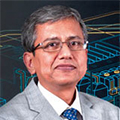ABB India

About: Subir Pal - Head of Discrete Automation and Motion Division
" Indian solar energy space is under-exploited. ABB India Ltd, a power and automation engineering company, is positioning itself for a bigger role in the solar energy space. India has an installed capacity of around 2,500 MW of grid-connected solar power, while the sector expects to add about 1,500 MW this year. The potential to grow in solar in India is very high as the Government aims to achieve a target of 10 GW by 2017, says Subir Pal, Head of Discrete Automation and Motion Division at ABB India. Subir Pal talks about the potential of India’s solar power sector and the company’s plans for the country. "
1. What role ABB is seeking to play in the solar energy sector?
ABB covers the entire electrical chain of a solar plant, barring the solar modules. The rest in the electrical chain is manufactured in-house. We have five divisions and each has some offering for solar plants. The solar power inverter is a core component ABB specialises in. Our first solar offering was made in 2009, and within a short time, we became market leaders as far as components are concerned. If you take the current installed base of a solar plant, roughly 2,500 MW has been installed in India, of which almost one-third feature ABB solar inverters. Apart from grid type projects, there are rooftop commercial applications as well.
2. Are you planning to expand your solar products plant?
We are manufacturing solar inverters at the Nelamangala facility in Bangalore. The plant has substantial capacity and is highly scalable.
We can expand volumes in one product and shrink them in another.
3. What are your views on the solar sector growth in India?
India is under-exploited as far as solar energy is concerned. The potential to grow in solar is very high. The Government aims to achieve 10 GW capacity by 2017. There is a lot of focus on solar and the good intention needs to be converted into action on the ground.
Another 1,500 MW grid-connected capacity could be added this fiscal. The rooftop segment is around 20 per cent of the entire market.
4. What are your plans on solar installations in rural India, especially in agricultural areas?
We are deeply into grid-type solar and well-placed in rooftop solar. The solar pump drive for the farm sector is a combination of solar inverter and variable speed drive.
The biggest electricity subsidy happens in the villages.
To get around the issue of grid connection, we can now install grid-independent solar pumps. We have 200 solar pumps in operation in Rajasthan and Madhya Pradesh.
5. How much does this cost?
It depends on the capacity of the pump drive the farmer needs. The cost can range from ?2 lakh to ?4.5 lakh, depending on the kW he uses. When you combine all the subsidies available from various pockets, it can be 50 to 80 per cent. The farmer does not draw the subsidy, the system integrator draws it from the MNRE (Ministry of New and Renewable Energy) channels The medium and large farmers will definitely opt for this kind of technology, but for the small farmers it will take time to spread.
6. What are your expectations from various solar segments?
We are very active in the grid connector solar sector. The rooftop solar sector is tied up with a few policy-related issues and once those issues are addressed, I am sure it will see an explosive growth. The solar pump segment is also emerging as a big opportunity.
Source:http://www.thehindubusinessline.com
